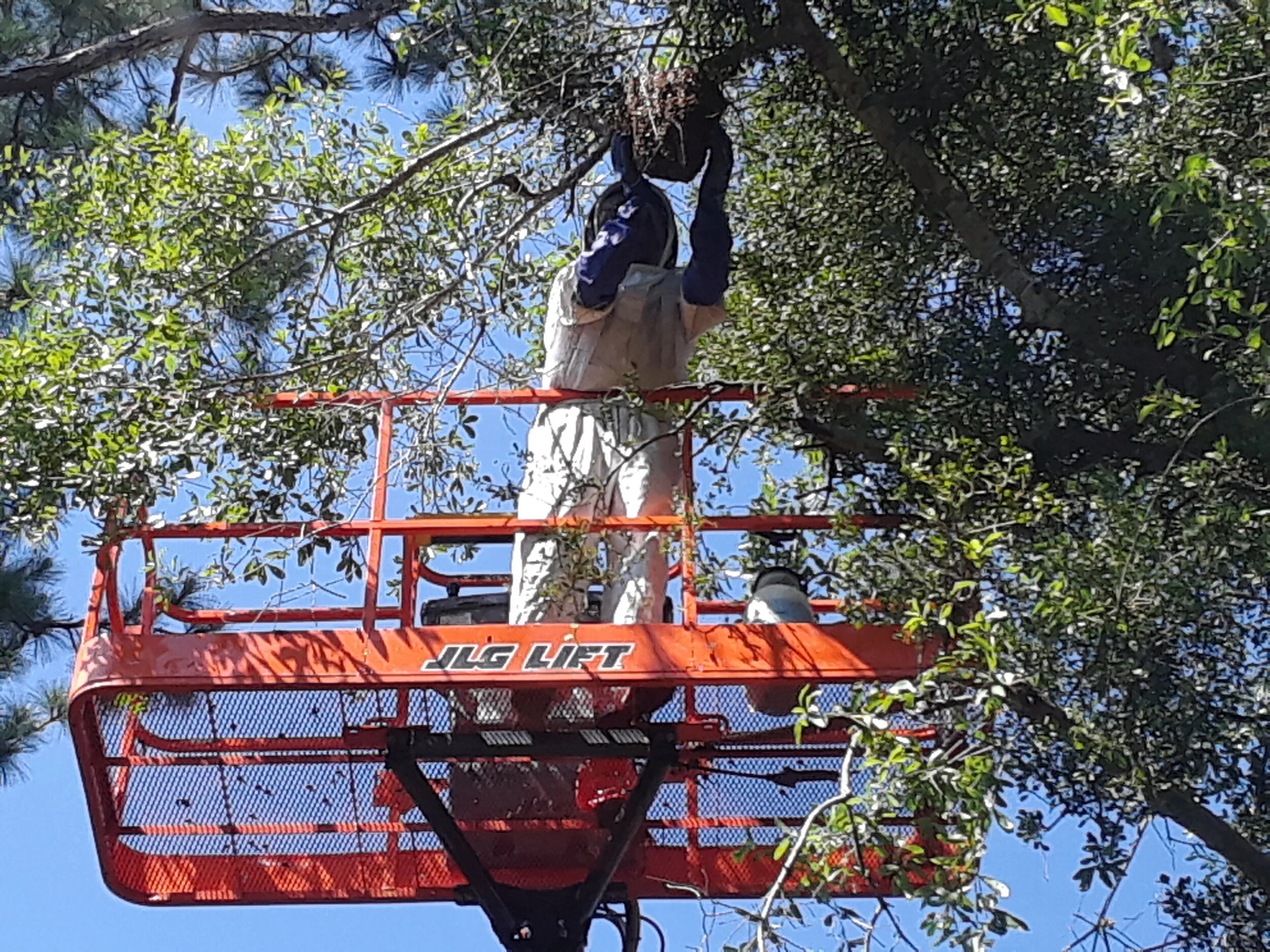How to get a free bee removal?
If you were wondering how to get free bee removals, you’re in the right place to find out!
In this post we’re going to discuss what are the costs to bee removals, what makes one expensive and what can be done for free. We’ll also give you information about what to look for when you’re choosing your bee removal and relocation service provider and why it’s important to save the bees instead of exterminating them.
Let’s get right into it.
First of all we already made a video where we explain free bee removals. If you’re interested check it out, It contains a lot of important bee information, but if you would rather have a longer more in detail description on free bee removals you should follow the post under the video.
So let’s say that you have a bee problem on your property that you want someone to deal with. You’re going to call up the first thing that comes up on Google for bee removal near me or pest control company. Hopefully for us that would be ecobeeremoval.com. You can contact us for bee removal services if you click here. We’re going to ask you four important questions:
How long have the bees been there?
Where is the bee nest located on your property?
How big is their nest?
So here comes the first question “How long have the bees been there?”
If your answer is 1 to 3 days you might just be eligible for a free bee removal. Everything longer than that is probably going to require specialized equipment and a lot of work. If you’re wondering why people aren’t just coming out to your location and removing the bees for free, since they’re getting honey and a hiveful of bees out of that the answer is pretty simple:
It’s sad, but It’s not worth it.
You see for example in Florida, the Department of Agriculture requires you to re-queen feral bee colonies. That means if we go out and get your feral hive, we’re going to have to purchase a new queen and even then, the colony might not accept that new queen and collapses. However if your bees just appeared. For example you see a ball of bees hanging from a tree, that will probably just be a bee swarm. Bee swarms are very easy to deal with in the first few days. If you call a bee relocation service provider and tell them that you have a ball of bees hanging on a branch in your garden They’ll probably tell you to wait 2 days. Swarms are bees that left a colony, one that they grew out, and are looking for a new home. These bee swarms in your garden are probably going to be gone by the evening or next morning. If they are still there in two day you’re still eligible for a free bee removal, because the bee removal service can just come out, snap the branch off from the tree, put it in a box and go.
Here comes the second question in place: where is the bee nest located on your property?
You see even if it’s a swarm that’s just a few days old, you might not get a free bee removal. If the swarm is easily reachable from the ground then It’s fine! Go and enjoy the view of someone coming out to deal with it for free, the view is going to be great, because bee removals are very very exciting. But, if the bees are up on a tree, or inside a structure or under your house, then you’re not going to get a free removal, and for the most part you won’t even want to! You see if bees are inside your house then what you want will be an open, clean, close bee relocation with warranty!
We at ecobeeremoval.com are giving you that exactly! If bees are inside your houses structure then someone will open the walls of your house, clean it out perfectly, because if it’s not clean, if the bees leave their smell behind, then another ball of bees will choose that location for their nest, you can get my word on it. Then once the cleaning is done those people will either leave it at that and give you the number of a handy-man service to close your structure, or will do it by themselves, like us, and there is only a handful of people like us who do this, because it requires you to have a lot of handy-man experience, and giving a warranty to every single customer is a big deal.
Or let’s say that you have a bee nest up on a tree. We have done that many times. Here’s a picture of how that would work:
Steven is 40 meters high on a lift to relocate some amazing, really beautiful, healthy honey bees.
Renting this lift by itself costs hundreds of dollars. You won’t see someone relocate your bees for free if they’re going to need this specialized equipment.
The third question is quite irrelevant to free bee removals, because if your bee nest has already gained size, then it will definitely require so much equipment and time to remove, that you won’t see a single pest control company relocating it for you for free. You might get someone to exterminate the bees, but that’s not economically viable, because the bee species are dying out and disappearing all over the world. By choosing someone who exterminates and not relocate, you will support a system, that’s slowly making honey bees extinct. Which is a huge problem for the planet's eco-system and for the food chain. Honey bees are the ones getting the job done, when it comes to pollinating the fruits and vegetables on our plates. If honey bees go extinct, food prices will skyrocket. There’s this quote attributed to Albert Einstein, of course it probably wasn’t him who said it, but nonetheless it’s true:
“If the bee disappeared off the face of the Earth, man would only have four years left to live.”
and we should keep it in our hearts. Always try to choose the business that relocates!
And for the last question, this is probably the hardest one to answer: What species of bees are you dealing with?
This one is easy on the surface. Most people will be able to tell a honey bee from a wasp. However, wasps can be dangerous sometimes and are not producing honey to prove valuable for bee keepers so they can’t be sold, only relocated. But there’s a bigger and harder problem on the bee side of things: are your bees honey bees or africanized bees?
Honey bee is our friend. They are not aggressive, they’re producing a lot of honey, they have to be re-queened, but that’s fine, it can be done, It might even worth it if it’s a young swarm, but africanized bees on the other hand are not at all like this. They are a problem mostly in the southern states for now, but they’re moving northern and northern every year. Africanized bees or killer bees are a species that were transported to Brazil in the seventies and I know it sounds cliché, but a few of them escaped the lab and started reproducing with honey bees. They are dangerous, and aggressive, and can kill your horses, lamb or even your dog, but what’s worse they can even kill humans. You won’t see someone from a bee relocation service go close to an africanized bee nest without a specialized suit exactly for that and that’s gonna cost you money. Also for example again, in Florida, the Department of Agriculture won’t let bee relocation services relocate africanized bees, so they’ll have to be euthanized, because of the lots and lots of dangers associated with them, so the service provider won’t even be able to resell them to beekeepers.
For more in detailed bee identification click here, we made a site just for that! We’re also working on a quiz that will help you to identify your bees!
But how to tell a honey bee apart from an africanized bee?
That’s really hard to do, because there are many different levels to hybridization, but there are two key things you can do to tell them apart, but they are a bit dangerous so bee careful!
Get close to the bee nest, but not two close and see if the bees come out and start following you, if they do and they follow you around for a long time, then they’re probably africanized. Killer bees are very protective of their habitat, and they’re known for following people around for even hundreds of meters.
The other way to tell is by their body size.
The average honey bee is 1.5 centimetres long. If the bees that you see out there are shorter, around 1 centimetres then they’re probably africanized and can’t be relocated for free.
What to do if you really need a free bee removal:
So this is a second option, many people don’t know about. You should open google, and search for bee keepers association and your county and state. There you’ll find bee keepers near you directly. Some bee keepers will go out and get the bees and re-queen them for you. But remember! Most bee keepers won’t get any bees out of your walls for free, and if they do they won’t be able to give you a warranty on the wall of your house. So only call them if you have easily accessible swarm of bees. Anything in or under a structure you gonna need someone like us, who does open, clean, close bee removal and relocation with a warranty.
So I hope this was comprehensive enough and you could learn something important! You can call us during the day, whenever you want for a free consultation, we’re going to ask you questions and go through everything that you’ll need. In the end of the call we’re going to give you a free estimate too, so you can decide if it’s worth it for you. Hope all of you will have a great bee-safe day!



